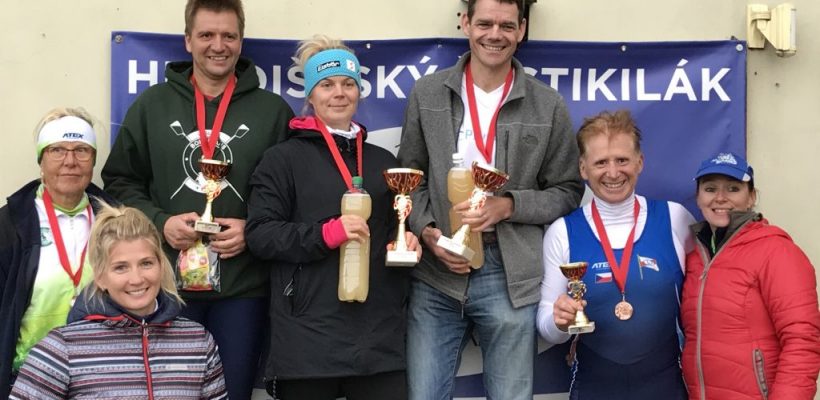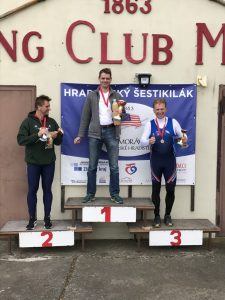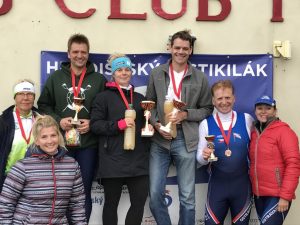
Introduction
I developed a training plan for myself to prepare for the Skiffhead (March 27th, 2022). This is my peak event for the spring head racing season, and I think this plan could be useful for other Masters rowers preparing for head races. This article describes the general principles and plan structure. The full training plan, including specific session plans, is available for purchase on Rowsandall. (If you are already on a paid plan on Rowsandall.com, you can get up to 100% discount on the plan’s price.)
I started sculling in 1984, at RV Naarden in The Netherlands, and I have competed as a Junior and student rower in The Netherlands, being reasonably successful, but not elite. I have always remained active in rowing and other sports, but in 2011 I decided to pick up competitive rowing again, this time in the Masters field. I set some goals for myself and achieved them, among others winning WRMR and Euromasters races, as well as many national level sprint and head races. I have kept a blog about my trainings until 2020: https://blog.rowsandall.com/
I have a pretty tasking job, leading a R&D department at a big, US based, corporation active in the Semiconductor industry, and I have a wife and 3 children. So, I have a limited amount of time for training, but have been successful because of the plans that I developed to get the best benefit from the limited time investment.
Who should use this plan?
I have written this plan with a Masters sculler in mind who
- Wants to prepare for a head race with a distance of around 7.5km.
- Has a demanding job and other obligations, and can free up about 6 to 7 hours per week over 6 sessions to train. Winning a head race will take more training (for most age categories), but with this training plan you can be competitive, and if you set realistic goals, you will have a successful race. You can use this plan as a basis and add sessions, but then you have to know what you’re doing.
- Has some experience doing structured trainings and following a training plan. I will give you some guidance on how to adapt the plan in case of injury, sickness, or travel, but you will have to figure out how to be flexible yourself.
Plan principles
The high level principles of the plan are as follows:
- No injuries
- Adapt the plan to reflect work constraints, sickness, stress and other external influences
- Steady state is the base. During all phases, the plan will contain steady state sessions.
- Periodization. The plan consists of different phases. Depending on the phase of the plan, the “hard” sessions will have a different character.
- Intervals are time based to allow a choice between on-the-water (preferred) and indoor rowing sessions (winter, resolve time pressure by eliminating the time you need to get to your rowing club). Breaks between intervals are active paddling.
- A weights session is not a luxury for Masters rowers
- Eat and drink wisely, and get enough sleep
When you sign up for the plan, you will receive an email explaining each of the principles in more detail.
Weights Sessions
Weights sessions are not optional for Masters rowers. Untrained people lose maximum strength and strength endurance as they get older. The “use it or lose it principle” applies here. The benefits of regular strength training are:
- Slow down loss of musculature with aging
- Positive effect on blood pressure and endurance performance
- Reduced risk of injury. By systematically strengthening muscles that are used less in rowing, you keep a balance which helps to prevent injuries.
On the other hand, weights sessions, if done incorrectly, can form a risk of injuries in itself. Therefore, I do not prescribe the weights sessions in detail, but ask you to either use your own experience, or ask a local, professional trainer to get you started and teach you the basic exercises.
You cannot learn to do weights exercises from YouTube. You have to have someone who knows what they’re doing stand next to you and give you instructions, ideally by showing and then correcting your execution directly.
Exercise machines train your muscles as well as free weights, and are designed to be safer. So, they are a good alternative if you are not 100% sure, or just starting with weights.
Bottom line: You know what you are doing, or you are getting local help to learn.
Crosstraining
I am not prescriptive about crosstraining either. These aerobic sessions should be easy and low-risk (for injuries). Do any sport that you like and can do well, be it running, swimming, ice speed skating, cross-country skiing or cycling.
If you have knees or feet that are easily injured, you might not want to go running, or avoid running on hard surfaces. If you live in an area where road cycling is not safe, you might want to consider a different form of crosstraining.
I like to do crosstraining outdoors during all seasons, because I like being out in the nature, and it has a positive effect on my mood and health. If possible in your environment, go outdoors. If this is not possible where you live (pollution, traffic, travel time to nature), try to make the crosstraining pleasant by doing a virtual ride or run, play some music, or exercise with friends.
The plan’s macro cycles
Week 1-6 are base building weeks. In the first three weeks, you get your first result on a couple of sessions that will keep returning as the plan progresses. In weeks 4 to 6, you will repeat the sessions of the first three weeks, and you should be able to improve on the marker sessions. Each training week will have 3 steady state rowing sessions, one interval rowing session, a cross training session and a weights session.
Weeks 7-12 are similar, but some of the hard sessions are replaced by sessions with shorter intervals, still with relatively generous rest breaks. The idea is to get your lactate production system simulated, which will also help you adapt to actually using lactate as fuel. Each training week will have 2-3 steady state rowing sessions, one or two “sprinterval” rowing sessions, a weights session and a crosstraining session.
Weeks 13-15. In this phase, the hard sessions are longer intervals (6-10 minute) around threshold pace with generous breaks. In week 15, we do a first “hard distance” session. Each training week will consist of three steady state sessions, one interval session, a crosstraining session and a weights session.
Weeks 16-18. Systematic preparation for the race distance and pace. Your mental toughness will increase, and you will discover what pace you can hold over the race distance by systematically working on hard distance work. Each training week will consist of two hard distance sessions, a steady state session, a recovery session, a weights session and a crosstraining session.
Weeks 19 and 20. Taper. In these weeks, we lower the number of sessions and limit their intensity. We will keep doing short bursts of race pace work. Week 19 ends with a simulation of the first 20 minutes of your head race. In week 20, there is even more rest time, and you may have to spend time to get your boat to the race venue. On race day, you should be well rested, prepared and eager to race. You should know exactly how hard you can go to finish the race and show your best performance.
What do I get when I purchase the plan?
When you purchase the plan on Rowsandall.com, you will receive
- An email with a detailed description of the plan, especially more detailed explanations of the principles described above. This document will also contain instructions on the training zones used and how to determine them.
- Each session will be prepared on your Rowsandall.com account and contain much more guidance and detailed instructions than in the plan summary that you can see on Rowsandall.com.
- Using your Rowsandall.com account, you can upload recorded sessions and match them with the plan. This allows you to track progress, set individual target paces and power levels for the sessions, and get automated notifications of breakthrough and marker sessions. This will make it very easy and motivating to stick to the plan.
- Email me with questions on the plan. While I am not a “white glove service” personal trainer, I am always willing to clarify, give feedback, and answer questions of paying subscribers.
- A proven way to prepare for head races.


